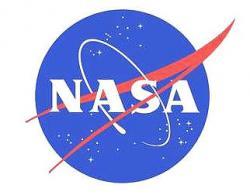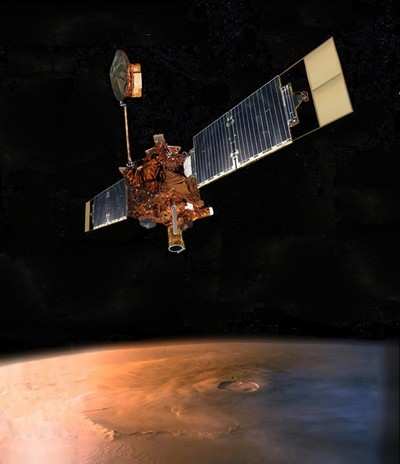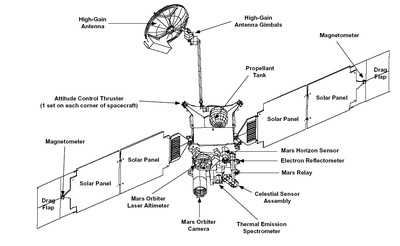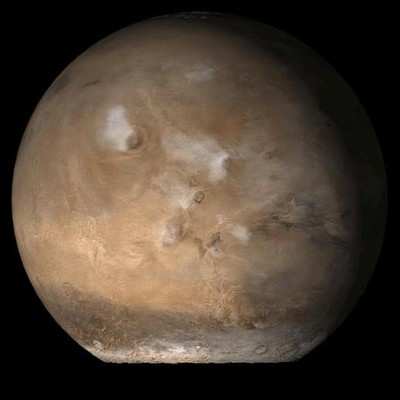All Good Things Must Come to An End...
 NASA tells ANN that
the justifiably lauded Mars Global Surveyor has likely
finished its operating career. The spacecraft has served the
longest and been the most productive of any mission ever sent to
the red planet.
NASA tells ANN that
the justifiably lauded Mars Global Surveyor has likely
finished its operating career. The spacecraft has served the
longest and been the most productive of any mission ever sent to
the red planet.
"Mars Global Surveyor has surpassed all expectations," said
Michael Meyer, NASA's lead scientist for Mars exploration at NASA
Headquarters, Washington. "It has already been the most productive
science mission to Mars, and it will yield more discoveries as the
treasury of observations it has made continues to be analyzed for
years to come." Its camera has returned more than 240,000 images to
Earth.
The orbiter has not communicated with Earth since Nov. 2.
Preliminary indications are that a solar panel became difficult to
pivot, raising the possibility that the spacecraft may no longer be
able to generate enough power to communicate. Engineers are also
exploring other possible explanations for the radio silence.
"Realistically, we have run through the most likely
possibilities for re-establishing communication, and we are facing
the likelihood that the amazing flow of scientific observations
from Mars Global Surveyor is over," said Fuk Li, Mars Exploration
Program manager at NASA's Jet Propulsion Laboratory, Pasadena,
Calif. "We are not giving up hope, though."

Efforts to regain contact with the spacecraft and determine what
has happened to it will continue. NASA's newest Mars spacecraft,
the Mars Reconnaissance Orbiter, pointed its cameras toward Mars
Global Surveyor on Monday. "We have looked for Mars Global Surveyor
with the star tracker, the context camera and the high-resolution
camera on Mars Reconnaissance Orbiter," said Doug McCuistion, Mars
Exploration Program director at NASA Headquarters. "Preliminary
analysis of the images did not show any definitive sightings of a
spacecraft."

The next possibility for learning more about Mars Global
Surveyor's status is a plan to send it a command to use a
transmitter that could be heard by one of NASA's Mars Exploration
Rovers later this week.
Mars Global Surveyor launched on Nov. 7, 1996, and began
orbiting Mars on Sept. 11, 1997. It pioneered the use of
aerobraking at Mars, using careful dips into the atmosphere for
friction to shrink a long elliptical orbit into a nearly circular
one. The mission then started its primary mapping phase in April
1999. The original plan was to examine the planet for one Mars
year, nearly two Earth years. Based on the value of the science
returned by the spacecraft, NASA extended its mission four
times.
"It is an extraordinary machine that has done things the
designers never envisioned despite a broken wing, a failed gyro and
a worn-out reaction wheel. The builders and operating staff can be
proud of their legacy of scientific discoveries and key support for
subsequent missions," said Tom Thorpe, project manager for Mars
Global Surveyor at JPL.
The spacecraft evaluated landing sites for the twin NASA rovers
that landed in 2004 and sites for future landings of the Phoenix
and Mars Science Laboratory missions. It monitored atmospheric
conditions during aerobraking by newer orbiters. It served as a
relay link for the rovers and provided mapping information about
their surroundings.

"When we watched the launch 10 years ago, we wondered if we
would make the specified mission length. We certainly were not
thinking of a 10-year operating life," said JPL retiree Glenn
Cunningham, who managed the Global Surveyor project through
development and launch.
A few of the mission's many important discoveries about Mars
include:
- The spacecraft's camera found gullies cut into many slopes that
have few, if any, impact craters. This indicates the gullies are
geologically young. Scientists interpret this as evidence of action
by liquid water, essentially in modern times.
- The mineral-mapping infrared spectrometer found concentrations
of a mineral that often forms under wet conditions, fine-grained
hematite. This discovery led to selection of a hematite-rich region
as the landing site for NASA's Mars Exploration Rover
Opportunity.
- Laser altimeter measurements have produced an unprecedented
global topographic map of Mars. The instrument revealed a multitude
of highly eroded or buried craters too subtle for previous
observation, and mapped canyons within the polar ice caps.
- The magnetometer found localized remnant magnetic fields,
indicating that Mars once had a global magnetic field like Earth's,
shielding the surface from deadly cosmic rays.
- The camera found a fan-shaped area of interweaving, curved
ridges interpreted as evidence of an ancient river delta resulting
from persistent flow of water over an extended period in the
planet's ancient past.
- A long life allowed Global Surveyor to track changes through
repeated annual cycles. For three Martian summers in a row,
deposits of carbon-dioxide ice near Mars' South Pole shrunk from
the previous year's size, suggesting a climate change in
progress.
JPL manages Mars Global Surveyor for the NASA Science Mission
Directorate, Washington.
 NTSB Final Report: Cozy Cub
NTSB Final Report: Cozy Cub ANN FAQ: Contributing To Aero-TV
ANN FAQ: Contributing To Aero-TV Classic Aero-TV: Seated On The Edge Of Forever -- A PPC's Bird's Eye View
Classic Aero-TV: Seated On The Edge Of Forever -- A PPC's Bird's Eye View ANN's Daily Aero-Linx (04.29.25)
ANN's Daily Aero-Linx (04.29.25) ANN's Daily Aero-Term (04.29.25): Execute Missed Approach
ANN's Daily Aero-Term (04.29.25): Execute Missed Approach






